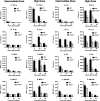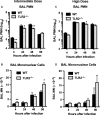Toll-like receptor 2 has a prominent but nonessential role in innate immunity to Staphylococcus aureus pneumonia
- PMID: 29142002
- PMCID: PMC5688782
- DOI: 10.14814/phy2.13491
Toll-like receptor 2 has a prominent but nonessential role in innate immunity to Staphylococcus aureus pneumonia
Abstract
Staphylococcus aureus is an important cause of acute bacterial pneumonia. Toll-like receptor 2 (TLR2) recognizes multiple components of the bacterial cell wall and activates innate immune responses to gram-positive bacteria. We hypothesized that TLR2 would have an important role in pulmonary host defense against S. aureus TLR null (TLR2-/-) mice and wild type (WT) C57BL/6 controls were challenged with aerosolized S. aureus at a range of inocula for kinetic studies of cytokine and antimicrobial peptide expression, lung inflammation, bacterial killing by alveolar macrophages, and bacterial clearance. Survival was measured after intranasal infection. Pulmonary induction of most pro-inflammatory cytokines was significantly blunted in TLR2-/- mice 4 and 24 h after infection in comparison with WT controls. Bronchoalveolar concentrations of cathelicidin-related antimicrobial peptide also were reduced in TLR2-/- mice. Lung inflammation, measured by enumeration of bronchoalveolar neutrophils and scoring of histological sections, was significantly blunted in TLR2-/- mice. Phagocytosis of S. aureus by alveolar macrophages in vivo after low-dose infection was unimpaired, but viability of ingested bacteria was significantly greater in TLR2-/- mice. Bacterial clearance from the lungs was slightly impaired in TLR2-/- mice after low-dose infection only; bacterial elimination from the lungs was slightly accelerated in the TLR2-/- mice after high-dose infection. Survival after high-dose intranasal challenge was 50-60% in both groups. TLR2 has a significant role in early innate immune responses to S. aureus in the lungs but is not required for bacterial clearance and survival from S. aureus pneumonia.
Keywords: Staphylococcus aureus; Alveolar macrophages; bacterial pneumonia; innate immunity; toll‐like receptor 2.
© 2017 The Authors. Physiological Reports published by Wiley Periodicals, Inc. on behalf of The Physiological Society and the American Physiological Society.
Figures








Similar articles
-
Contribution of toll-like receptor 2 to the innate response against Staphylococcus aureus infection in mice.PLoS One. 2013 Sep 13;8(9):e74287. doi: 10.1371/journal.pone.0074287. eCollection 2013. PLoS One. 2013. PMID: 24058538 Free PMC article.
-
Modulation of paired immunoglobulin-like type 2 receptor signaling alters the host response to Staphylococcus aureus-induced pneumonia.Infect Immun. 2010 Mar;78(3):1353-63. doi: 10.1128/IAI.00969-09. Epub 2010 Jan 11. Infect Immun. 2010. PMID: 20065029 Free PMC article.
-
mCLCA3 modulates IL-17 and CXCL-1 induction and leukocyte recruitment in murine Staphylococcus aureus pneumonia.PLoS One. 2014 Jul 17;9(7):e102606. doi: 10.1371/journal.pone.0102606. eCollection 2014. PLoS One. 2014. PMID: 25033194 Free PMC article.
-
Immunopathogenesis of Craniotomy Infection and Niche-Specific Immune Responses to Biofilm.Front Immunol. 2021 Feb 23;12:625467. doi: 10.3389/fimmu.2021.625467. eCollection 2021. Front Immunol. 2021. PMID: 33708216 Free PMC article. Review.
-
[New insights in the pathogenesis and treatment of rosacea].Duodecim. 2012;128(22):2327-35. Duodecim. 2012. PMID: 23342479 Review. Finnish.
Cited by
-
Immunometabolites Drive Bacterial Adaptation to the Airway.Front Immunol. 2021 Nov 25;12:790574. doi: 10.3389/fimmu.2021.790574. eCollection 2021. Front Immunol. 2021. PMID: 34899759 Free PMC article. Review.
-
The Role of Innate Immunity in Pulmonary Infections.Biomed Res Int. 2021 Jan 22;2021:6646071. doi: 10.1155/2021/6646071. eCollection 2021. Biomed Res Int. 2021. PMID: 33553427 Free PMC article. Review.
-
Context-Dependent Roles for Toll-Like Receptors 2 and 9 in the Pathogenesis of Staphylococcus aureus Osteomyelitis.Infect Immun. 2022 Nov 17;90(11):e0041722. doi: 10.1128/iai.00417-22. Epub 2022 Oct 13. Infect Immun. 2022. PMID: 36226943 Free PMC article.
-
Associations of Toll-like Receptor Gene Polymorphisms with NETosis Activity as Prognostic Criteria for the Severity of Pneumonia.Sovrem Tekhnologii Med. 2021;13(3):47-53. doi: 10.17691/stm2021.13.3.06. Epub 2021 Jun 28. Sovrem Tekhnologii Med. 2021. PMID: 34603755 Free PMC article.
-
Exosomes and chronic rhinosinusitis.World J Otorhinolaryngol Head Neck Surg. 2018 Nov 1;4(3):175-178. doi: 10.1016/j.wjorl.2018.07.005. eCollection 2018 Sep. World J Otorhinolaryngol Head Neck Surg. 2018. PMID: 30506048 Free PMC article. Review.
References
-
- Armstrong, L. , Medford A. R., Uppington K. M., Robertson J., Witherden I. R., Tetley T. D., et al. 2004. Expression of functional toll‐like receptor‐2 and ‐4 on alveolar epithelial cells. Am. J. Respir. Cell Mol. Biol. 31:241–245. - PubMed
MeSH terms
Substances
LinkOut - more resources
Full Text Sources
Other Literature Sources

